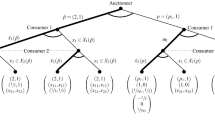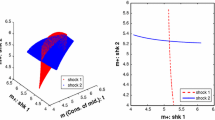Abstract
The paper studies a two-stage economy where consumers choose first the asset structure and then use it in a standard general equilibrium framework to transfer wealth across time and states of nature. The financial structure is chosen by maximizing indirect utility functions, using continuous random selections from the second-stage equilibrium correspondence. We depart from Bisin (J Econ Theory 82:19–45, 1998) where an endogenous beliefs approach was used and the asset creation was left to financial intermediaries. Moreover, our approach allows us to go beyond a mixed strategies result as we obtain an approximate equilibrium in pure strategies for the economy with incomplete information about future endowments.
Similar content being viewed by others
References
Aliprantis C. and Border K. (1999). Infinite Dimensional Analysis: A Hitchhiker’s Guide, 2nd edn. Springer, Berlin
Allen, B.: Continuous random selections from the utility correspondence. CARESS Working Paper No 85-25, University of Pennsylvania, Philadelphia (1985)
Allen B. (1994). Randomization and the limit points of monopolistic competition. J. Math. Econ. 23: 205–218
Allen F. and Gale D. (1988). Optimal security design. Rev. Financ. Stud. 1: 229–263
Arrow K.J. and Debreu G. (1954). Existence of an equilibrium for a competitive economy. Econometrica 22: 265–290
Bisin A. (1998). General equilibrium with endogenously incomplete financial markets. J. Econ. Theory 82: 19–45
Braido L. (2005). General equilibrium with endogenous securities and moral hazard. Econ. Theory 26: 85–101
Debreu G. (1982). Existence of competitive equilibrium. In: Arrow, K. et al. (eds) Handb. Math. Econ., vol. II, pp 697–743. North Holland, Amsterdam
Duffie D. and Jackson M. (1989). Optimal innovation of futures contracts. Rev. Financ. Stud. 2: 275–296
Duffie D. and Rahi R. (1995). Financial market innovation and security design: An introduction. J. Econ. Theory 65: 1–42
Faias M., Moreno-Garcia E. and Páscoa M. (2002). Real indeterminacy of equilibria and manipulability. J. Math. Econ. 37: 325–340
Fundenberg D. and Tirole J. (1995). Game Theory. MIT Press, Cambridge
Hara C. (1995). Commission-revenue maximization in a general equilibrium model of asset creation. J. Econ. Theory 65: 258–298
Mas-Colell A. (1985). The theory of general equilibrium: a differentiable approach. Cambridge University Press, Cambridge
Mas-Colell A. and Nachbar J. (1991). On the finiteness of the number of critical equilibria, with an application to random selections. J. Math. Econ. 20: 397–409
Milgrom P. and Weber R. (1985). Distributional strategies for games with incomplete information. Math. Oper. Res. 10: 619–632
Pesendorfer W. (1995). Financial innovation in a general equilibrium model. J. Econ. Theory 65: 79–116
Royden H. (1968). Real Analysis, 2nd edn. Macmillan, New York
Simon L. and Zame W. (1990). Discontinuous games and endogenous sharing rules. Econometrica 58: 861–872
Stahn H. (1998). On monopolistic equilibria with incomplete markets: the case of an exchange economy. J. Math. Econ. 29: 83–107
Author information
Authors and Affiliations
Corresponding author
Additional information
I am specially grateful to Mário Páscoa for several helpful suggestions and discussions and I also thank Emma Moreno-García for valuable comments and conversations. I am thankful for comments from C. Hara and J.K.-H. Quah and seminar participants at the 6th SAET Conference and 12th European General Equilibrium Workshop. Financial support from Fundação Amélia de Melo (Portugal) and from Portuguese Ministry of Science and Technology (Project no 1772) is gratefully acknowledged.
Rights and permissions
About this article
Cite this article
Faias, M. Approximate equilibrium in pure strategies for a two-stage game of asset creation. Decisions Econ Finan 31, 117–136 (2008). https://doi.org/10.1007/s10203-008-0081-4
Received:
Revised:
Accepted:
Published:
Issue Date:
DOI: https://doi.org/10.1007/s10203-008-0081-4




